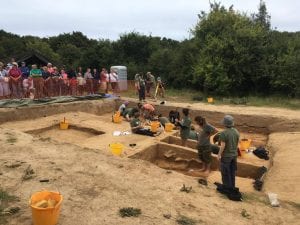Mammoths and Magdalenians: A Summer in the Ice Age
By Josie Mills, on 30 August 2017
This August I swapped the busy streets of London for the beaches and archaeology on the island of Jersey, which is located close to the Normandy coastline in the English Channel. Jersey is an incredibly archaeologically-rich location with many prehistoric and historic sites of interest. The project that I work with is called Ice Age Island (twitter hashtag: #iceageisland) and we are particularly focused on archaeological deposits from the Middle Palaeolithic, Upper Palaeolithic and Mesolithic sites on the island.
Jersey is currently an island but during cooler periods of the Pleistocene (Ice Age), when sea level fell, it regularly became part of the larger Channel landmass of the Continental Shelf. The Ice Age Island team are a group of researchers and students focused on unravelling this part of the island’s past by exploring terrestrial sites on the island but also investigating how humans used the wider, now submerged, landscape that surrounded it. Currently work is focused on reconstructing geological and topographical mapping of the Continental Shelf and also working out how artefacts from the sites we are excavating and studying can contribute to our understanding of behaviour in the offshore area.
Fig 1. A map showing the location of Jersey and the other Channel Islands. Numbered locations refer to Middle Palaeolithic sites in the area: 1= Le Rozel, 2= La Cotte a la Chèvre, 3 = La Cotte de St. Brelade, 4 = Mont Dol
My PhD is focused during the Middle Palaeolithic of Jersey when Neanderthals visited the island, particularly the site of La Cotte de St. Brelade on the south-west coast. La Cotte is a sheltered cave-like area formed within a granite t-shaped ravine system and has recorded Neanderthal activity intermittently from around 240,000 to 40,000 years ago. The work that I do helps to contribute to the understanding of how Neanderthals interacted with the offshore landscape, particularly where they got the raw material needed to make stone artefacts from. The use of stone, particularly flint, to make tools was key to survival for Neanderthals. Tools made from stone were used for activities like hunting, food processing, and preparing hides—giving access to food, nutrition, defence, and warmth. Flint presence and absence fluctuates in the deposits at La Cotte and by understanding differences in the types of raw materials in the different archaeological layers we hope to reconstruct a model of the availability of different sources; this will in turn shed light on Neanderthal behaviour in the wider landscape. So this summer I’ve swapped three museums for one museum archive in Jersey where I have been analysing flint tools from La Cotte!
Fig 2: View into the t-shaped ravine system at La Cotte de St. Brelade (own image)
However Ice Age Island is made up of multiple strands of investigation and the most active is the archaeological training dig and field school, which UCL has been involved in for seven excavation seasons. The site is run by Dr Ed. Blinkhorn (Senior Archaeologist UCL and Archaeology South East), and supported by supervisors and students from different universities. Excavation is focused on the Magdalenian (a time period spanning 17,000 – 12,000 years ago) site of Les Varines, where the archaeological deposits are dated to approximately 14,000 years ago.
Fig 3. Students and staff working at the excavation during the site open day (own image)
The current interpretation is that the site represents a hunter-gatherer camp where Magdalenian people lived for some parts of the year. Located at the sheltered apex of a wide valley system the site would have been a prime position for tracking migrating animals, like deer and horse, in the landscape below. However the story of Les Varines has changed through the seven years the site has been excavated. Initially the artefacts that were found appeared disturbed by post-depositional processes and were not excavated in the original position they were left by the Magdalenian people. This limited the behavioural inference that could be taken from the artefacts. However as new trenches and test pits were put in, guided by geophysical survey, areas of intact Upper Palaeolithic archaeology were discovered!
This year has been a really exciting excavation season as the type of finds being made have diversified from flint tools to include a mammoth tooth and multiple constructed hearth areas. This allows a much more varied picture of life at the site, demonstrating different activities the Magdalenian people were carrying out!
https://www.youtube.com/watch?v=Nv1n5KSOlXs
Ed Blinkhorn and Letty Ingrey (UCL/ Archaeology South East) talking about the potential mammoth tooth find
https://www.youtube.com/watch?v=p7RAOEDLcGc&t=5s
UCL MSc Palaeolithic Archaeology and Palaeoanthropology students Leah and Fiona discussing uncovering the Magdalenian Hearth Features
So if you haven’t seen my in a museum for a while – that’s what I’ve been up to!
One Response to “Mammoths and Magdalenians: A Summer in the Ice Age”
- 1
 Close
Close





[…] of Neanderthal populations surviving during very cold periods of the Ice Age, for example at La Cotte de St. Brelade in Jersey. There are archaeological deposits from this site that date to Marine Isotope Stage 6 […]